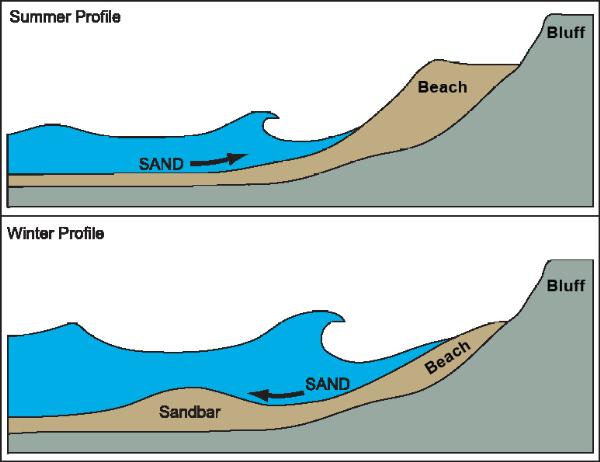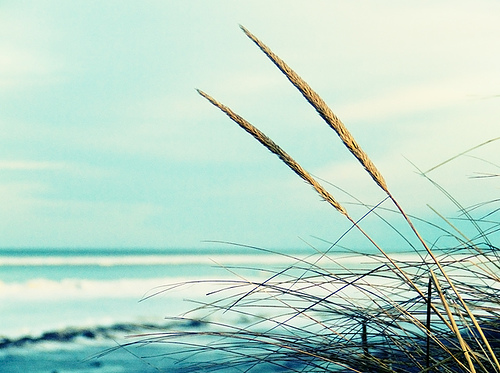Parlee Beach, with its limited shore frontage, is one of the most
popular beaches (400,000 visitors/year) in the Atlantic Provinces
of Canada. However, development of visitor facilities and intensive
visitor use prior to the 1970's resulted in the destruction of its
beach-dune environment. A decreased quality of visitor experience
due to the erosion of the sand beach resulted in public outcry for
its restoration. This resoration was achieved in the late 1970's
and as a result, this is a spectacular place of recreation and
relaxation.
The beach and dunes of Parlee Beach are the result of constant
action of the wind, tides, and ocean currents. After every storm,
the shape of the dunes change. Critical to the retention of the
dunes are the dune grasses in the spring, summer, and fall; and the
snow and ice in the winter.

Sand on the beach is constantly being moved around. As you can
see, each wave that comes in pushes around the sand on the beach,
turning the ocean water at the shore brown. The difference in
energy between summer and winter waves drastically changes the look
of the beach.
To examine this seasonal change, it is good to have names for
the different parts of the beach. In this case, we’ll look at three
parts, the backshore, the foreshore, and offshore.
The backshore begins at the vegetated cliffs to the high tide
level and is comprised of the berm and berm crest. The berm is the
relatively flat sandy area where everyone loves to put their beach
towels. At the berm crest, beach slopes more steeply to the high
tide level. The width of the berm changes seasonally. During the
summer it is wider than during the winter. This change in width
results in the moving shoreward or seaward of the next two
zones.
The foreshore begins at the high tide line and stretches to the
low tide line. This section of beach in usually slopes downward at
a uniform level. Because of the tides, this section of beach is
periodically below sea level or above sea level.
Beyond the foreshore is the offshore beginning begins at the low
tide line and extending off shore. This section of the beach is
always below sea level but constantly affected by the waves. The
offshore profile changes seasonally. During the summer, it is a
relatively uniform slope down. During the winter, a trough (low
point) forms with mounds of sand (bars) eroded from the berm
shoreward and seaward of the trough.
The seasonal changes noted above are caused by the different
energy levels of summer and winter waves. Winter storms generate
shallow waves with more energy than summer waves. The winter waves
erode sand off the beach and store it in offshore bars.
The winter waves are generated by local storms. They form large
waves that do not extend deep beneath the ocean surface. Thus as
they crash on the shore they have enough energy to pick up sand and
pull it off of the foreshore into deeper water where the shallow
waves do not reach. The largest storm generated waves also erode
the face of the berm crest, reducing the width of the berm. The
sand is then deposited in sandbars off-shore.
During summer, the waves are generated by storms far out to sea.
These waves are milder but because they have been traveling across
greater distances, they have developed into deeper waves. As these
waves come to shore they pick up the sand that was deposited int he
off-shore sand bars and transport it back onto the foreshore. As
the water flows back to the ocean, there is not enough energy to
transport as much sand as the wave brought onto the forshore back
off shore, resulting in a net gain of sand. This results in the
gradual build up of the berm crest and the berm widens for the
summer.
This discussion has dealt only with the seasonal on and
off-shore transport of sand. There are many other processes
occurring with sand transport at the coast including longshore
transport, river replenishment, etc.

In order to log this earthcache, please
complete the following:
1. Post a picture of the dunes, with you
and/or you GPSr clearly in the picture;
2. Estimate the percentage of the dunes that are protected with
grass, or snow/ice if you're there in the winter. Email me your
answer.
